AudioQuest GO-4 Internal Wire Replacement For The SDA SRS 1.2TL
Comments
-
Oh Ray are you in for a treat..
-
DK, I don't know how to break it to you but according to WBT's Website the WBT QD25 quick disconnect is Gold plated brass, not copper sorry.
Thanks Tony. Here are the responses I received from the vendor, Handmade Electronics, and WBT:
=======================================================================
Subject: Re: Customer Inquiry - WBT QD25 Quick Disconnect
I was told copper but if they publish brass, it's brass.
Not the first time I was given incorrect information. I
have had these for years and maybe at the time they were
copper and later switched to brass for better grip.
Usually this type of connector is high copper content
or pure copper. As copper is constantly creeping up in price
maybe this style connector will get switched over to brass.
A.Cirella
Handmade Electronics
=======================================================================
Subject: RE: QD25 Metal - Copper or Brass
Hello,
It is made from brass. WBT is currently prototyping a pure copper version. Since
copper is so soft, they have had to re-engineer the original design for the
terminal to retain its 'spring'.
Regards,
Rich Moore
WBT-USAProud and loyal citizen of the Digital Domain and Solid State Country! -
DarqueKnight wrote: »I placed an order today for ten Duelund CAST Silver/Carbon resistors to replace the Mills in my 1.2TL's. I ordered the long 10 watt version with extra long leads ($6.70 extra per resistor). Dueland said the long 10W resistors offered a small improvement performance over the shorter 5W versions. I plan to mount them on the back side of the board.
I received notice that my Duelund resistors shipped today.Proud and loyal citizen of the Digital Domain and Solid State Country! -
DarqueKnight wrote: »I received notice that my Duelund resistors shipped today.
Me too!!! LOL!!!
Yes I ordered another set!! -
Ray,
Did yours show up today? Mine are at FedEx I have to pick them up this afternoon.. -
Ray,
Did yours show up today? Mine are at FedEx I have to pick them up this afternoon..
Yes, I installed mine yesterday. The Duelunds are a little more transparent than the Mills, but at 13 times the cost of the Mills, I am not impressed. Duelund advised "5 good days" of listening time before they reach maximum sound quality, so maybe they will get better. Did you notice any improvements with time?
The lead of one resistor broke off when I was installing it and another resistor had a loose lead that appeared to be close to popping off. I ground off some of the plastic casing and resoldered the leads. Duelund is sending replacements for those resistors.
I was able to install all 5 resistors on the back side of the board, although I had to stack two of the resistors and I had to cut away the Black Hole damping material over the stacked resistors. In all my years as an electronics hobbyist, this was the first time I had a component lead come off.Proud and loyal citizen of the Digital Domain and Solid State Country! -
DarqueKnight wrote: »In all my years as an electronics hobbyist, this was the first time I had a component lead come off.
well correct me if I'm wrong, But aren't they just graphite sticks with a lead wrapped around and a dap of solder in cardboard ? -
I did notice improvement after a few days. But I noticed an improvement right out the gate.. I will take a look at mine today on the lead issue, that is not good at all. Did you contact them about the problem?
I love how transparent they are compared to the mills. I really thought this would be an upgrade you would love. -
Did you contact them about the problem?
Of course:DarqueKnight wrote: »Duelund is sending replacements for those resistors.well correct me if I'm wrong, But aren't they just graphite sticks with a lead wrapped around and a dap of solder in cardboard ?
The CAST Silver resistors are graphite sticks encased in hard plastic with silver wire leads.Proud and loyal citizen of the Digital Domain and Solid State Country! -
I did notice improvement after a few days. But I noticed an improvement right out the gate.. I will take a look at mine today on the lead issue, that is not good at all. Did you contact them about the problem?
I love how transparent they are compared to the mills. I really thought this would be an upgrade you would love.
Agreed. I noticed an immediate improvement compared to Mills. Although, I also installed the Clarity Cap ESA's along with the Duelund resistors which also improved transparency. I did notice an improvement with time as well, but the biggest improvement was "right out of the gate" as Larry stated. I too thought this would be an upgrade you would love Ray. Although, the problem(s) with the resistors put a damper on the "wow" factor somewhat I am sure. give us an update after you install the replacement resistors and let them burn in a little Ray. I am hoping you will be impressed with the results. I certainly was.
Taken from a recent Audioholics reply regarding "Club Polk" and Polk speakers:
"I'm yet to hear a Polk speaker that merits more than a sentence and 60 seconds discussion."
My response is: If you need 60 seconds to respond in one sentence, you probably should't be evaluating Polk speakers.....
"Green leaves reveal the heart spoken Khatru"- Jon Anderson
"Have A Little Faith! And Everything You'll Face, Will Jump From Out Right On Into Place! Yeah! Take A Little Time! And Everything You'll Find, Will Move From Gloom Right On Into Shine!"- Arthur Lee -
DarqueKnight wrote: »Of course:
Yeah I saw that after the fact and to late to edit.. Glad they are taking care of you..
I checked mine out and they look to be good. Unfortunately it will be awhile before I use mine for the plans I have.. -
Ray do you have a diagram of the 1.2TL internal wiring you could email me?
Thanks - Not Tom ::::::: Any system can play Diana Krall. Only the best can play Limp Bizkit.
- Not Tom ::::::: Any system can play Diana Krall. Only the best can play Limp Bizkit. -
Ray do you have a diagram of the 1.2TL internal wiring you could email me?
Thanks
The only wiring diagrams I have are the ones in the SDA schematics sticky. These are also included in the last two pages of the schematics section of the SDA Handbook.Proud and loyal citizen of the Digital Domain and Solid State Country! -
I am looking for like -
Connector - 24" to first driver, from first driver to second, 15", etc etc
I did not know if you took those notes or not...
Thanks- Not Tom ::::::: Any system can play Diana Krall. Only the best can play Limp Bizkit. -
I have always wondered the same thing as another poster mentioned about the amount of money being spent on the wire fed to the binding posts. I have never saw this kind of upgrade before and also did not understand why not very many people do it. Those pictures confirm why no one does it and your results confirm why everyone should do it
-
I am looking for like -
Connector - 24" to first driver, from first driver to second, 15", etc etc
I did not know if you took those notes or not...
Thanks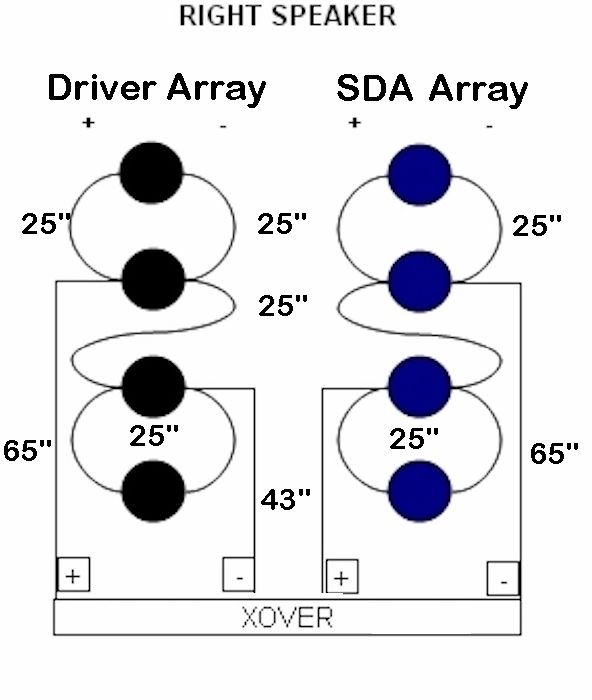
The tweeter wire lengths are given in the last entries in the table below: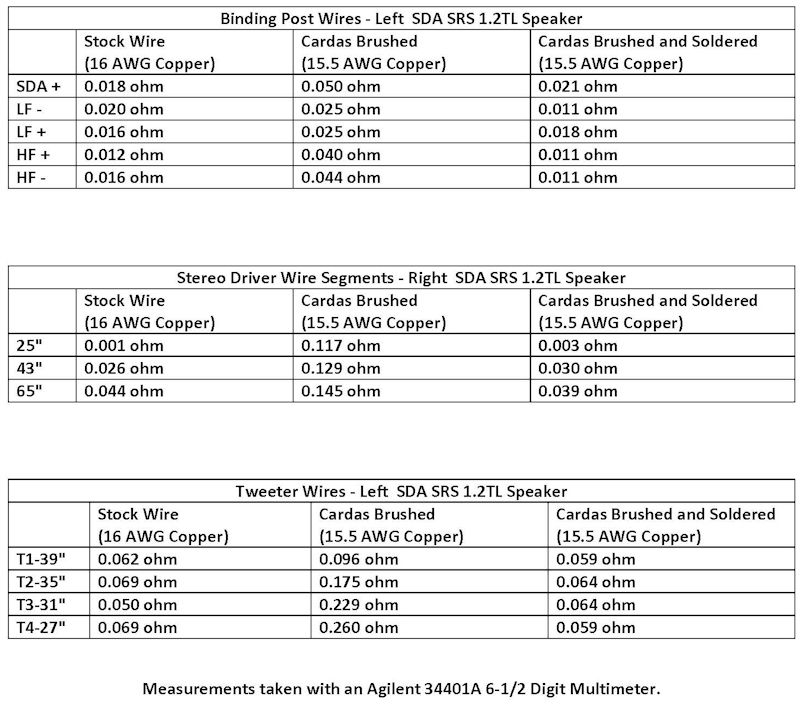
The binding post wires were 24".Proud and loyal citizen of the Digital Domain and Solid State Country! -
Duelund Drama
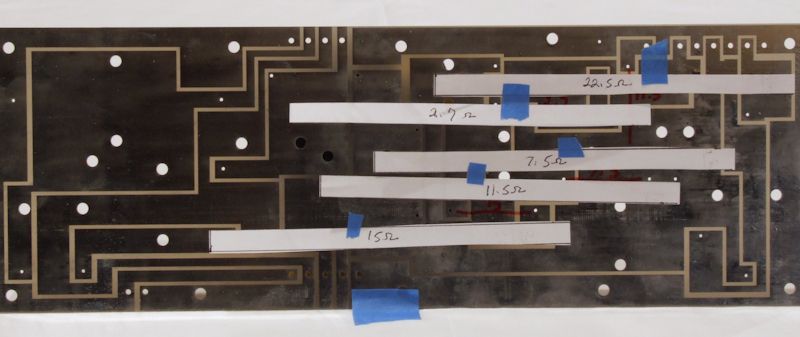
Figure 1. Duelund resistor placement mockup.
Paper cutouts with the same footprint as the Duelund CAST resistors were arranged on the back of a prototype sample of my SDA SRS 1.2TL crossover board. I ordered long leads and how long the "long leads" were. This is the response I received from Duelund:
"They are made so they easily cross each other on the middle of the resistor. I make them by hand, so I just make them looong."
Based on that vague, non-quantitative reply, and knowing that the resistors were 5.3" long, I guessed that the leads would be at least 4" long. The actual leads measured 4.2" to 5.1" long.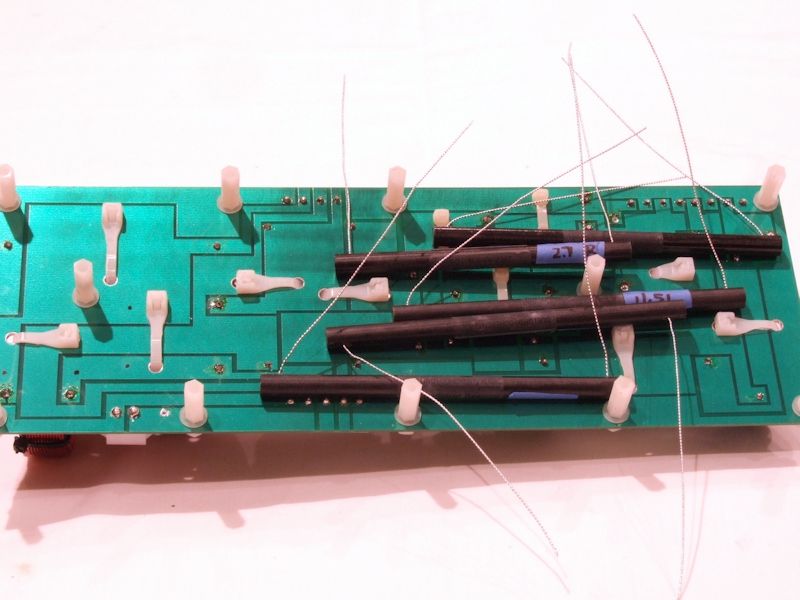
Figure 2. Actual resistor arrangement.
Due to the locations of the resistor through-holes and obstructions on the back of the board, the 11.5 ohm resistor had to be stacked on top of the 2.7 ohm resistor.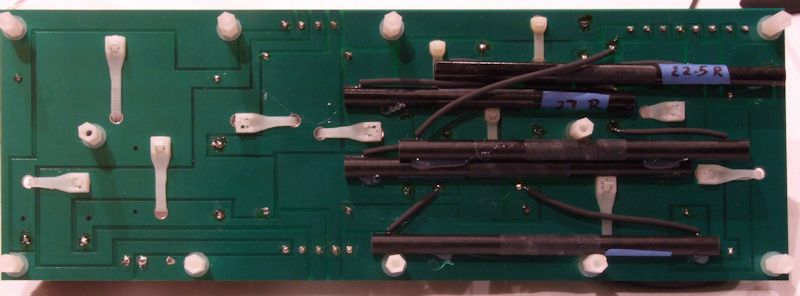
Figure 3. What a mess - Duelund resistors installed. The leads are covered with 3/16" shrink wrap.
The resistors were secured to the board with a pad of hot glue at each end.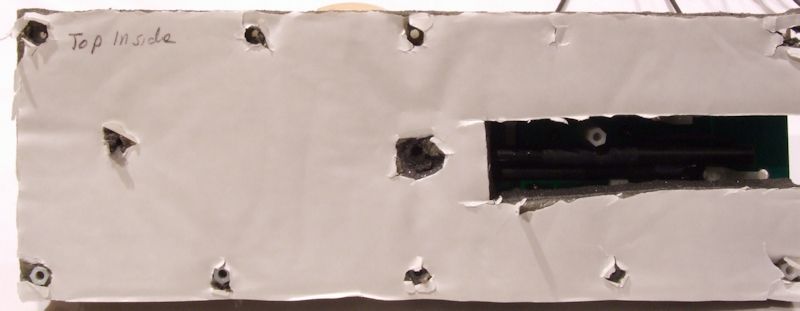
Figure 4. Cutout in the Sonic Barrier Black Hole damping material.
Sonic Barrier Black Hole damping material is placed between the circuit board and its same-size structural support board. I cut away the damping material in the area of the stacked resistors to avoid excess pressure on them. I found out the hard way that Duelund resistors are somewhat delicate.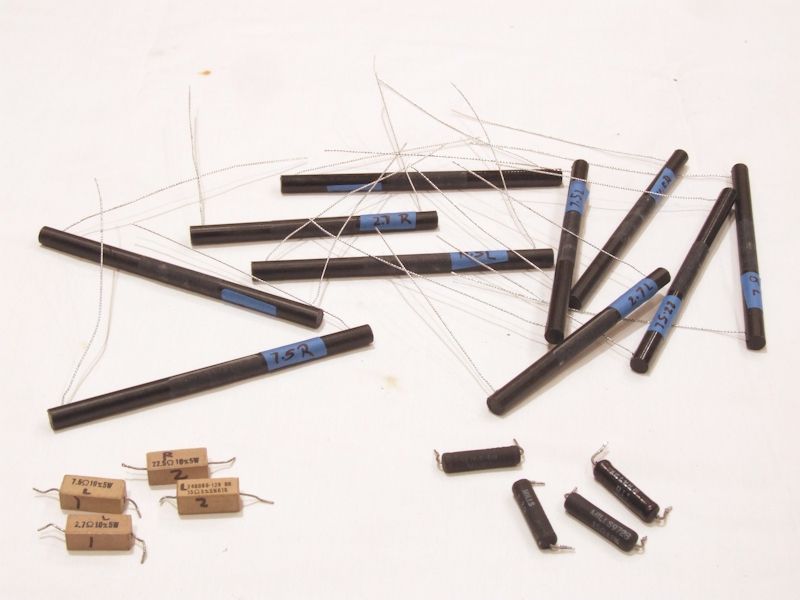
Figure 5. Licorice sticks, bricks and regular looking resistors. Clockwise from bottom left: original ceramic
metallic resistors, Duelund carbon resistors, Mills MRA-12 wire wound resistors.
Noise spectrum measurements with an oscilloscope showed that the Mills passed a cleaner signal than the cermet resistors and the Duelunds passed a cleaner signal than the Mills. The increase in transparency was immediately apparent, but it was more modest than I expected.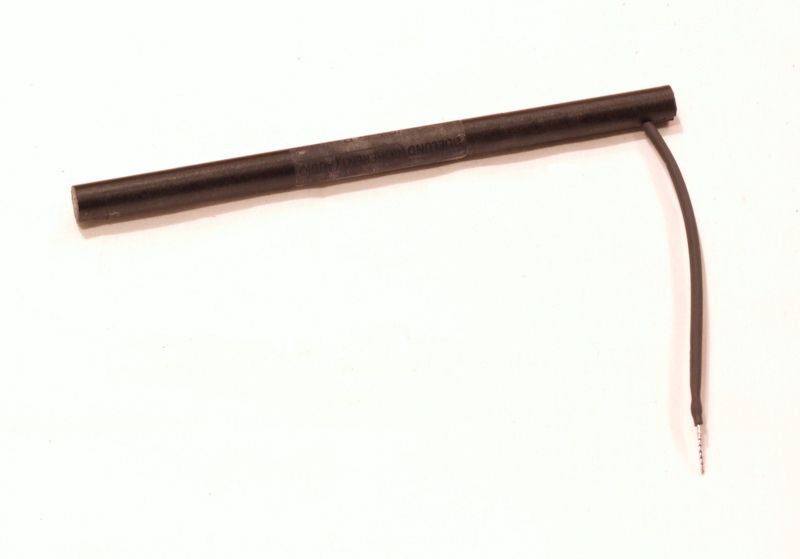
Figure 6. One lead of one of the 11.5 ohm resistors broke off with normal handling during installation. I
soldered it back on. Duelund is sending a replacement.
In all my years and years as an electronics hobbyist since teenage, I have never had a component lead to break...until now...with my $65 a piece boutique resistors.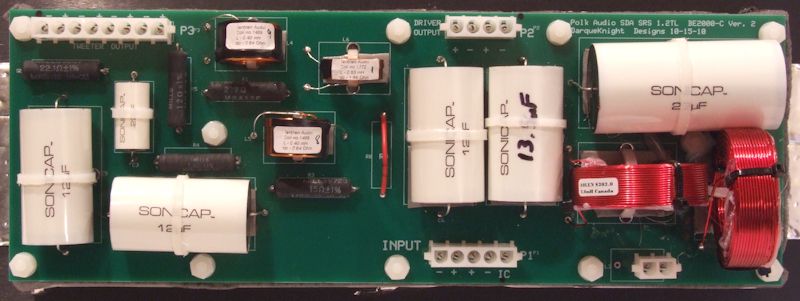
Figure 7. SDA SRS 1.2TL crossover board with Mills MRA-12 resistors.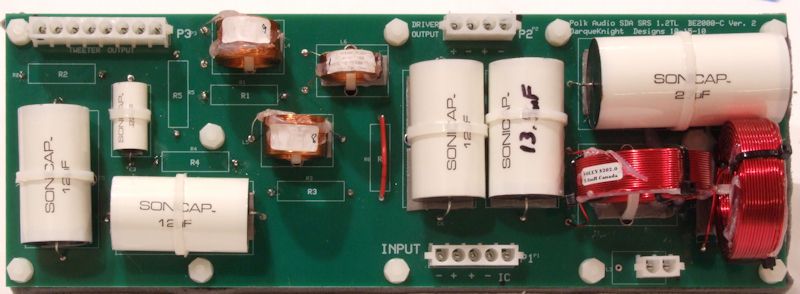
Figure 8. SDA SRS 1.2TL crossover board with Duelund CAST Silver resistors on the back.
I received this reply when I asked Duelund about break in time for the CAST Silver resistors:
"5 days good playing."
Since I don't know what a day of good playing is, I am going to assume it is a typical day's listening, say 10 hours, rather than an entire 24 hour day. That would generously put "5 days good playing" as 50 hours. Since I am letting the radio play overnight and when I am away from home, it will only take a little over two days to reach the equivalent of "5 days good playing". As of now, I have 27 hours of listening time on the Duelunds.
After the Duelund's are finished soaking, I can play with my new Pass Labs XP-30 preamp: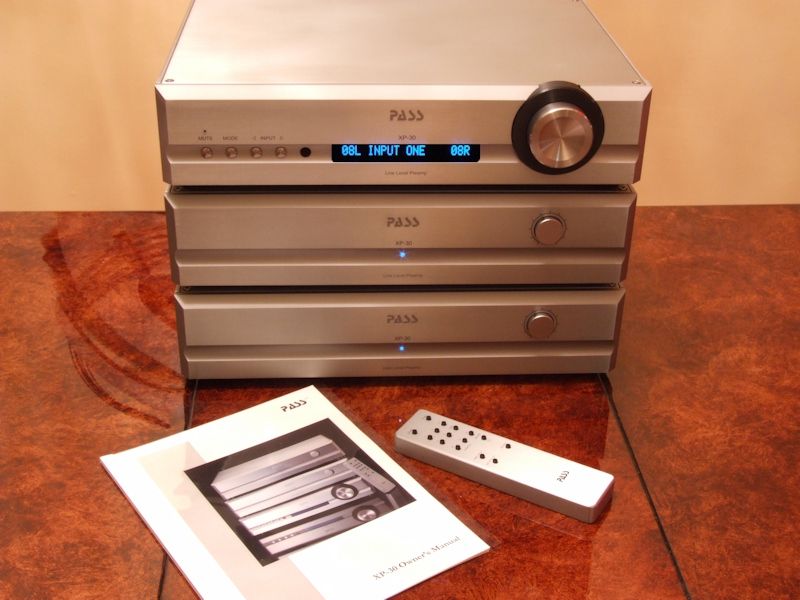
Figure 9. According to Pass Labs, the XP-30 requires 36 hours of warmup from a cold start.
This was a one month old dealer demo, so I assume no further break in is required.Proud and loyal citizen of the Digital Domain and Solid State Country! -
Nice looking pre-amp there Ray!
With regards to the Duelund resistors, could it be that the transparency of the Duelunds is revealing the lower transparency of the Sonicaps possibly? As I said, I have never heard the Sonicap/Duelund combo so I have no basis of comparison. I was very impressed by the transparency of the Clarity Cap ESA/Duelund combination vurses the Sonicap/Mills combination however. Do you think the Duelunds could be revealing weaknesses of the Sonicaps, possibly? I know you are directly comparing the Sonicap/Mills vurses the Sonicap/Duelund and basing your listening thoughts upon these comparisons, but can the greater transparency of the Duelund resistors reveal to you the weakness of the Sonicap capacitors?
Taken from a recent Audioholics reply regarding "Club Polk" and Polk speakers:
"I'm yet to hear a Polk speaker that merits more than a sentence and 60 seconds discussion."
My response is: If you need 60 seconds to respond in one sentence, you probably should't be evaluating Polk speakers.....
"Green leaves reveal the heart spoken Khatru"- Jon Anderson
"Have A Little Faith! And Everything You'll Face, Will Jump From Out Right On Into Place! Yeah! Take A Little Time! And Everything You'll Find, Will Move From Gloom Right On Into Shine!"- Arthur Lee -
I know you are directly comparing the Sonicap/Mills vurses the Sonicap/Duelund and basing your listening thoughts upon these comparisons, but can the greater transparency of the Duelund resistors reveal to you the weakness of the Sonicap capacitors?
Other people have been impressed with the Sonicap/Duelund combination, so I don't think my results are an indictment of the Sonicap's quality. Different systems, different synergy, different ears, different results.Proud and loyal citizen of the Digital Domain and Solid State Country! -
I ponder the thought of purchasing Duelund Cast Silver Resistors that Toolfan and DarqueKnight are using - either for my 1.2TLs or to be used in another system. I went on VR3's advice and replaced my Mills resistors with Mundorf MoX Resistors in my 1.2TLs. As VR3 promised, they removed a veil when comparing them with the Mills Resistors. The results were immediate and impressive. (I should also mention that I am now using Jupiter Caps for the Tweeters and Clarity Cap MR for the drivers and SDA. The Jupiters and Mundorfs went in at the same time 3 weeks ago and have some break-in time, the Clarity Caps went in last week - still being broken in.)
DK - just curious if had any reservations using the Mundorf Metal Oxide Resistors?
As always, I am looking forward to DKs input after the break in period is complete.Statistics show that 98% of us will die at some point in our lifetime.
The other 2% will work for WalMart. -
PolkMaster1 wrote: »DK - just curious if had any reservations using the Mundorf Metal Oxide Resistors?
I don't have any personal experience with the Mundorf MOX resistors. I have read that they impart a metallic sheen...which some people like.Proud and loyal citizen of the Digital Domain and Solid State Country!




